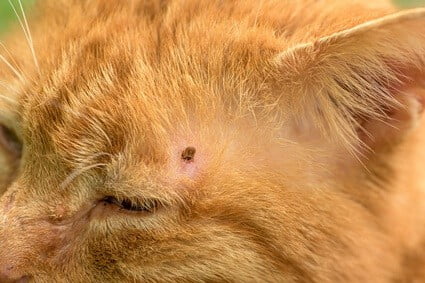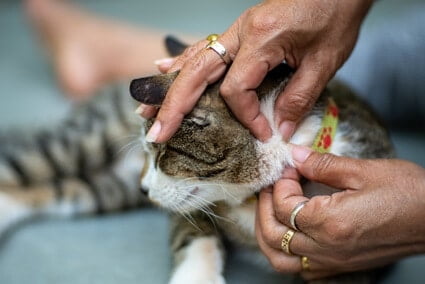Scabs on a cat’s head and body are unpleasant to look at and can make you feel concerned about your pet’s skin health. What’s more, a scab can easily become a scar if picked at or scratched off.
Scabs on a cat’s skin are normally due to miliary dermatitis. Feline skin condition develops due to allergies, parasites, fungal or bacterial infections, and overly dry skin. If sharp, unsheathed claws are used to remove an itch, they may break the skin, so scabs form as the wounds heal.
If your cat has scabs on its head or back, these mustn’t be picked at or scratched off. This will open up the wounds and could result in permanent scars. Instead, find out why your cat has miliary dermatitis. Scabs are a symptom, not the reason for the problem. So, you need to identify the cause so that your cat can make a full recovery.
Why Does My Cat Have Scabs?
Scabs on a cat’s head and body can be uncomfortable, leading to a constant itching sensation. The scab will drop off when scratched with sharp claws, leaving an open wound that can invite bacterial infection.
It’s a misconception that most scabs are caused by fighting. It’s true that cats battle over territory or for mates. However, most cats back down before it comes to physical confrontation. Hissing, growling, and aggressive body language are intended to avoid conflict, not provoke it.
It is likelier that your cat has feline miliary dermatitis. This condition is so named as it causes small lesions on the skin that resemble millets. This will lead to spotty and flaky skin, which in turn causes itching and scabs.
What Causes Feline Miliary Dermatitis?
Miliary dermatitis has many causes but can be avoided if you remove the trigger for the skin reaction.
Unfortunately, this isn’t always possible. Some cats develop idiopathic dermatitis with no clear explanation. This may have been an inherited skin condition from a parent.
Some cat breeds are likelier to experience skin issues than others. Veterinary Dermatology names Devon Rex, Abyssinian, and Domestic Mixed breeds as those at highest risk.
If you can’t find a reason for feline dermatitis, skip straight to treatment as the problem is likely to be genetic.
1/ Allergies
Allergies are the most common explanation for scabs on a cat’s skin as they have various causes.
Felines allergies have a range of symptoms, including:
- Constant scratching
- Presence of hives and hotspots on a cat’s skin
- Sneezing and coughing
- Streaming eyes and nose
- Trouble breathing
- Vomiting and diarrhea
Itching is the most notable symptom. When a cat scratches to excess, it breaks the skin. This is especially likely if the skin is already covered in hives or hotspots. Then, scabs will form on the affected skin.
The cause of an allergy needs to be identified, but a vet will rarely be able to do this through testing. You’ll need to learn what is causing the reaction through trial and error.
Once you have done so, remove all exposure to the trigger.
Food
Food allergies are the most common sensitivities felines experience.
Cats can be allergic to many ingredients, and some human foods are outright toxic to cats. However, even cat food can cause an adverse reaction.
Cats can develop allergies at any time of life. Even if the food didn’t previously cause problems, this may not continue to be the case. So, be vigilant about a sudden allergic reaction after a cat eats.
If your cat has an allergic reaction to food, you need to remove one food at a time to identify the culprit.
Insect Stings or Bites
If your cat is stung by a bee or wasp, it may experience an allergic reaction. The most serious of these is anaphylaxis, which will require emergency medical treatment. Even a mild allergy will cause discomfort.
It is not just stinging insects that can cause these problems. Insects that bite, such as fire ants, may provoke a reaction. Arachnids like spiders, which can bite, and scorpions, which can sting, can cause an allergic reaction.
Many cats like to chase bugs. Insects and arachnids’ rapid, skittering movements activate a cat’s hunting instincts. While this is normally a harmless behavior, be mindful of allergic reactions after the event.
Plastic
Some cats have an allergy to plastic. Many cat food bowls, water bowls, and toys are made of plastic.
Switch your cat’s bowls to ceramic or porcelain alternatives. You could even get a water foundation. This will prevent your cat’s from touching any material while drinking. For mealtimes, use a flat food dish.
Fabrics and Household Products
Cats are curious animals. They’ll investigate anything in the home, especially if it has a new scent. This can lead to allergic reactions. For example, your cat may be sensitive to the material of a new cushion or curtain.
In addition, check if you’ve recently changed household products. A new fabric softener may cause a skin reaction in cats. The same can apply to air fresheners or perfume/cologne.
If your cat suddenly has scabs after changing household products, you should switch back.

Environmental Allergies
If your cat roams outside, it may have environmental allergies. This may be something commonplace, such as grass. Alternatively, the cat may have a seasonal allergy as felines experience an equivalent to hayfever.
So, run some basic experiments. Keep your cat home for 3 days, checking if this improves your cat’s skin. Allergies tend to take hold quickly, so this short Timeframe is long enough to test the environmental allergy theory.
If your cat still experiences outbreaks of scabs, something closer to home is causing the problem. If not, you’ll need to retrain your cat to stay home. Indoor cats can still live full, happy lives, but you’ll need to make some lifestyle changes.
2/ Parasites
The term parasites is broad, typically covering fleas, ticks, mites, and intestinal worms.
Worms are unlikely to cause skin issues as they’re internal organisms that dwell in a cat’s stomach or colon. Threadworms can be linked to flea infestations, though.
The other parasites that can lead to scabbing on a cat’s head and body include:
Fleas
All cat owners are aware of the omnipresent nuisance of fleas. These tiny parasites are always looking for cats to feed on. This causes the cat to itch constantly, and cats can even experience allergies to flea saliva.
The only way to manage flea infestations is through preventative action. Ensure that your cat is regularly treated with an anti-parasite spot-on treatment. There are also some natural flea treatments available.
Even if you keep your cat indoors, you’ll need to manage flea exposure. Fleas can attach to human clothing and enter the home this way.
Don’t assume that a cat is immune to fleas because it doesn’t mingle with other animals or go outdoors.
Mites
Mites are often confused with fleas, but they cause different issues.
Mites are usually found in a cat’s ears because they feed on ear wax. They can subsequently spread around the head and body, leading to mange.
Mange causes patches of dry skin all over the cat’s body, will itch profusely, and scab over. Unless the mange is treated, the itching will continue. The scabs will usually be scratched off by a cat’s claws.
Mange can be treated with a specialist shampoo. Prescription antibiotics may also be required to manage skin inflammation. However, mange can be prevented. Most anti-flea treatments will also prevent mites.
Ticks
Ticks differ from mites and fleas in that they’re external parasites.
Ticks are arachnids that attach to a cat’s skin. Then, the tick will feed on the cat’s blood. The more blood the tick consumes, the more visible it will be. The tick’s body will become bloated and dark as it feeds.
Ticks don’t cause itching, but can pass on diseases. A tick may have fed on a wild animal and, in doing so, become diseased via the animal’s blood.
If you see a tick on your cat’s head or body, follow these steps to remove it:
- Put on a pair of gloves and find a pair of tweezers
- Grasp the tick with the tweezers as close as possible to the skin
- Pull the tick away in one straight, fluid motion
- Place the tick in a sealed jar, ideally containing alcohol
Never twist a tick’s body while it is attached to the cat. In doing so, you will only remove the head. The tick’s teeth may remain within the cat’s body. Once the tick is removed, kill it through drowning.
After the tick is removed, a scab can form over the bitten area.
3/ Bacterial or Fungal Infections
A cat may have scabs due to an existing bacterial or fungal infection.
The more time a cat spends outdoors, the more external elements it’ll encounter. Even fighting with other cats can lead to an infection.
Here are some of the bacterial and fungal conditions that can cause cats to get scabs:
Feline Acne
Feline acne commonly forms around a cat’s chin. In many respects, it resembles human acne. The skin will become inflamed, covered in blackheads, pimples, and pustules. These will eventually scab over.
The Japanese Journal of Veterinary Dermatology notes that any cat, regardless of age, sex or breed, can develop acne. Sometimes, the problem can be treated at home.
If cleaning clears up the acne, no further treatment is needed. This was a temporary outbreak, potentially hormonal in nature. If the problem persists, your cat’s skin may have a bacterial infection that requires antibiotics.
Pus Pockets (Pyoderma and Abscesses)
Pyoderma is a bacterial infection caused by pus in a cat’s skin.
Pyoderma usually arises due to excessive bacteria. If your cat is not grooming properly, the risk is heightened. Stress can also provoke an outbreak of pyoderma.
Pyoderma was long thought to be rare in cats. However, Clinical Techniques in Small Animal Practice explains that it’s more common than previously believed.
Pyoderma is always worth investigating as a possible explanation for scabs on the skin. If pyoderma is diagnosed, your cat will be prescribed antibiotics.
Abscesses are concentrated areas of bacterial pus on the skin, and they usually arise from puncture wounds, such as bites from other animals. Abscesses are an ever-present danger if your cat is prone to fighting.
As an abscess is clearly visible, a vet will drain the pus. If bacteria has entered your cat’s bloodstream, antibiotics will be required to prevent further scabs from forming on the skin.
Pemphigus
Pemphigus foliaceous (PF) is a rare autoimmune disease in cats.
PF causes a cat’s immune system to work to excess. Rather than focusing on harmful invaders, it indiscriminately kills all bacteria in the body, leading to crusty scabs all over the body.
Veterinary Dermatology recommends a corticosteroid called prednisolone to treat PF. This drug has a 97% success rate in causing complete remission of PF within two months.
Ringworm
Ringworm, also known as dermatophytosis, is a common and highly contagious fungal infection.
Ringworm is caused by a fungus called Microsporum canis, which causes dry, circular patches of skin to form on a cat’s skin. This is where the name ringworm comes from.
These patches of dry skin will be itchy and uncomfortable. Your cat will scratch, and as the skin is already delicate, it’ll break. Scabs will form, and scarification becomes likely.
The Journal of Feline Medicine and Surgery explains that medically prescribed shampoos and creams are used to treat ringworm. Microsporum canis fungi are shed regularly, so you’ll need to quarantine your cat until fully recovered.

4/ Dry Skin
If a cat has dry skin, its flesh will become increasingly delicate and itchy. Dry skin makes it likely that your cat will open a wound by scratching, and scabs will follow.
Common causes of dry skin in cats include:
- Lack of moisture in the air
- Unbalanced diet that’s void of key nutrients
- Excessive time in the sun
- Wrong shampoo when bathing
- Lack of grooming due to arthritis or obesity
- Excessive grooming, usually caused by stress
- Dehydration
Indoor cats are prone to dry skin during the winter. When the ambient temperature drops, artificial heating sources are turned on. This can lead to a lack of moisture in the air. Consider getting a humidifier to improve the air quality.
Moisturize your cat’s skin. Apply feline-friend moisturizing lotions, such as shea butter and coconut oil.
Cat Scab Treatment And Control
If you find scabs on a cat’s skin, don’t pick at them as the skin will bleed and could become infected by bacteria.
Here’s how to prevent scabs from forming:
Prevention of Scabs
If your cat is scratching or grooming to excess, check if your cat has miliary dermatitis.
This starts by identifying the trigger for your cat’s skin complaint. You may only need veterinary intervention if your cat has an infection or genetic issue.
All cats scratch on occasion, so take steps to protect your cat from general scratching. Keep your cat’s claws at a managable length. A scratching post will assist. Don’t declaw your cat.
If your cat is prone to territorial conflict with other felines, keep them indoors.
Soothing Scabs
Focus on soothing your cat’s skin, but avoid using human products. Cats have delicate skin with a different pH level, and human medications can make the situation worse.
Your pet store will stock a range of steroid creams designed for feline skin complaints. Scabs are comparatively common, so there will be plenty of choices.
Creams and ointments won’t necessarily heal scabs, but they’ll reduce any inflammation and itching. This means that your cat is likelier to leave the scabs alone, allowing them to heal over and come away naturally.
Don’t ignore scabs on your cat’s head and body. Your cat will be in discomfort, experiencing constant itching, leading to further scabbing. Identify the cause and take action, whether through treatment, diet, or lifestyle changes.

